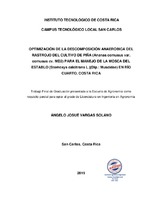Optimización de la descomposición anaeróbica del rastrojo del cultivo de piña (ananas comusus var. comusus cv. md2) para el manejo de la mosca del establo (stomoxys calcitrans l.)(dip.: muscidae) en Río Cuarto, Costa Rica
Resumen
Pineapple cultivation is the second crop of agricultural importance in Costa Rica. The stable fly (Stomoxys calcitrans) is a pest that develops on the stubble of the pineapple crop after the end of the production cycle, which has a negative impact on livestock production activities. With the objective of optimizing the anaerobic decomposition of the crushed pineapple stubble to reduce the presence of the pest, the present study was carried out at the Anexco farm, Río Cuarto, Costa Rica. The study consisted the evaluate of internal stubble temperature, weight loss and the emergence of stable fly as a result of the decomposition under the combination of: 1) days of plastic coverage (10, 20 and 30 days), application of three products Biological decomposers of matter (Terrabiosa®, Bioactivated® and EM-1®), and 3) the application or not of lime [Ca (OH)2]. The temperature of the decomposing stubble showed significant differences according to the biological product, with ranges between 36.73 °C and 43.71 °C in the superficial part of the cord (p = 0.0046) and 34.83 °C at 39, 30 °C in the inner part of the cord (p = 0.0375). The weight loss showed statistical differences between the biological product factors and coverage time (p <0.0001). The most influential factor in weight loss was the coverage time, where treatments at 20 and 30 days of coverage showed an average of 43.01% decomposition, while at 10 days it was 17.93%. On the other hand, the non-application of lime showed a 5.52% greater weight loss with respect to the application (p = 0.0056). Regarding the emergence of the fly, there was a tendency to decrease the number of fly as the days of stubble decomposition increase (p = 0.0266), related to the decomposition of the stubble.
Descripción
Tesis (Licenciatura en Ingeniería en Agronomía). Instituto Tecnológico de Costa Rica, Escuela de Agronomía, 2019.


